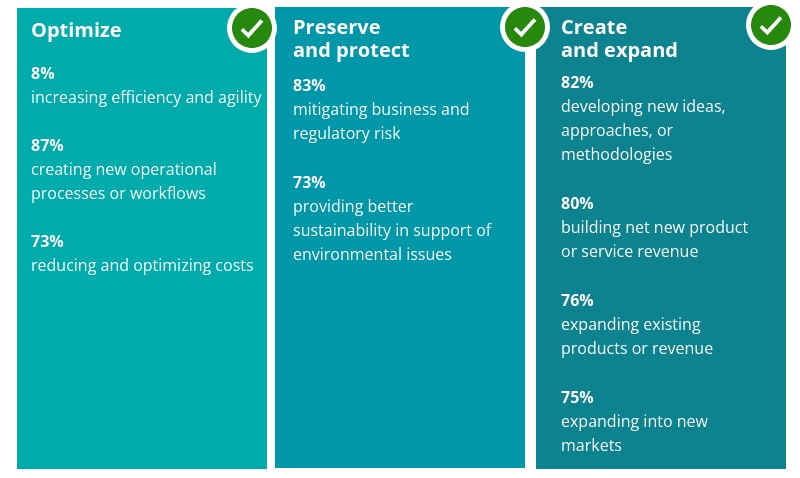Measuring tech value | Deloitte US has been saved
A blog post by Subodh Chitre, principal, Deloitte Consulting LLP, Monitor Deloitte Strategy, Michael Wilson, principal, Deloitte Consulting LLP, Monitor Deloitte Strategy, Lou DiLorenzo, managing director, Deloitte Consulting LLP, Monitor Deloitte Strategy, Tim Smith, principal, Deloitte Consulting LLP, Monitor Deloitte Strategy, Diana M. Kearns-Manolatos, senior manager, Deloitte Services LP, Deloitte Center for Integrated Research, Tim Bottke, senior partner, Deloitte Germany, Monitor Deloitte Strategy
Every enterprise is undergoing some form of digitization or digital transformation, and the vast majority aren’t realizing the full value potential. Part of the problem is most organizations don’t have a holistic way to connect, assess, and understand the total value related to tech investments. They over-index on operating margin and asset efficiency measures at the expense of others such as revenue growth. They further struggle to link revenue growth down to the technology estate. And when they get both right, they still tend to focus more on short-term ROI than longer-term value.1
Leaders need a way to connect the dots, close the gaps, and revisit how big, bold technology investments can drive long-term value. A new Monitor Deloitte report explains how, and what it comes down to is a common value frame that enables companies to better optimize, preserve, and create value now and into the future.
Create an end-to-end view of value
Whether making an investment in cloud, tech talent, or agile, CXOs can use an enterprise value map (EVM) to create a common frame for enterprise value measures, outcomes, and drivers. The EVM can then inform the enterprise’s digital transformation objectives linking specific business capabilities with decisions related to the technology estate (figure 1). While this may seem simple, it’s not how most organizations approach measuring tech value today.
Build the business case
Cloud migration is a great case in point. Operating margin reduction and asset efficiency savings are (relatively) straightforward to estimate—whether data center decommissioning or platform refactoring. The challenge comes in estimating the upside (revenue growth) from cloud-native operations. Many organizations can’t or don’t quantify how investing in a technology asset (cloud) to enhance their enterprise capabilities may enable them to retain and grow usage by current customers, increase their volume, and ultimately grow revenue. But it does. And that’s the value shortfall some companies are missing in their metrics, across many business programs and across long-term time horizons.
While not mutually exclusive, organizations can focus on three value objectives to build business cases that draw on this approach.
Optimize: An enterprise that wants to optimize its business can look for opportunities to use cloud technology to improve efficiency and quality, understanding that beyond operating margin and asset efficiency gains there can be revenue realization as well. As with the above example, enterprises largely do a good job with these operating margin plays.
Preserve and protect: An enterprise with an objective to preserve and protect value may invest in technologies focused on cloud cybersecurity, resiliency, or digital trust, which may positively impact its customer management, allowing the enterprise to more easily acquire new customers, increase volumes, and positively impact revenue.
Create and expand: While cloud investments certainly contribute to business outcomes like efficiency and agility, cloud investments also are adding considerable value as companies look to create and expand revenue through new products and capabilities. Here, tech investments can be explicitly directed to enable new capabilities, build new products, or reinvent within a market.
Prove the value
While technology-enabling enterprise cost savings is certainly important, IT investments can, do, and are adding more value than most organizations may know. Data from Deloitte’s 2022 US Cloud survey shows that cloud investments were to a moderate or large extent driving positive outcomes in each of these areas, according to respondents:
Look into the future
With tech investment decisions moving beyond the IT department and into the C-suite, leaders need a better, more holistic, and more accurate way to assess tech’s impact on enterprise value. This enterprisewide view can enable better, more cost-effective decision-making. It also can provide the strategic foundation CXOs need to make bold, long-term bets on the technology that can transform their business.
To obtain more information about this topic, read the research: A better way to estimate technology's impact on enterprise value
Get in touch

Lou DiLorenzo Jr.
Lou DiLorenzo serves as the national leader of Deloitte Consulting’s AI & Data Strategy practice and the Deloitte US CIO and CDAO Executive Accelerator programs. He is a member of Deloitte’s Generative AI practice leadership team and heads the Generative AI Incubator. With over 20 years of cross-sector operating, entrepreneurial, and consulting experience, he has a successful record of bringing key stakeholders together to help lead change, develop new capabilities, and deliver positive financial results. Previously, DiLorenzo served as COO of a consumer health insurance startup and as Global CIO for the...

Tim Smith
Tim is a principal with Deloitte Consulting LLP and serves as the US leader for Monitor Deloitte’s Technology Strategy & Business Transformation practice. He has more than 20 years of cross-sector technology advisory and implementation experience in the United States and abroad. Tim works with clients to unlock the value within the technology estate via integrated choices across operating models, architectures, and ecosystems. Tim resides in New York City. He earned a BSc in systems engineering from the University of Virginia and an MBA from the London Business School.

Diana Kearns-Manolatos
Diana Kearns-Manolatos is a senior research leader with Deloitte Services LP’s Center for Integrated Research, where she leads Deloitte’s global research on digital transformation.



